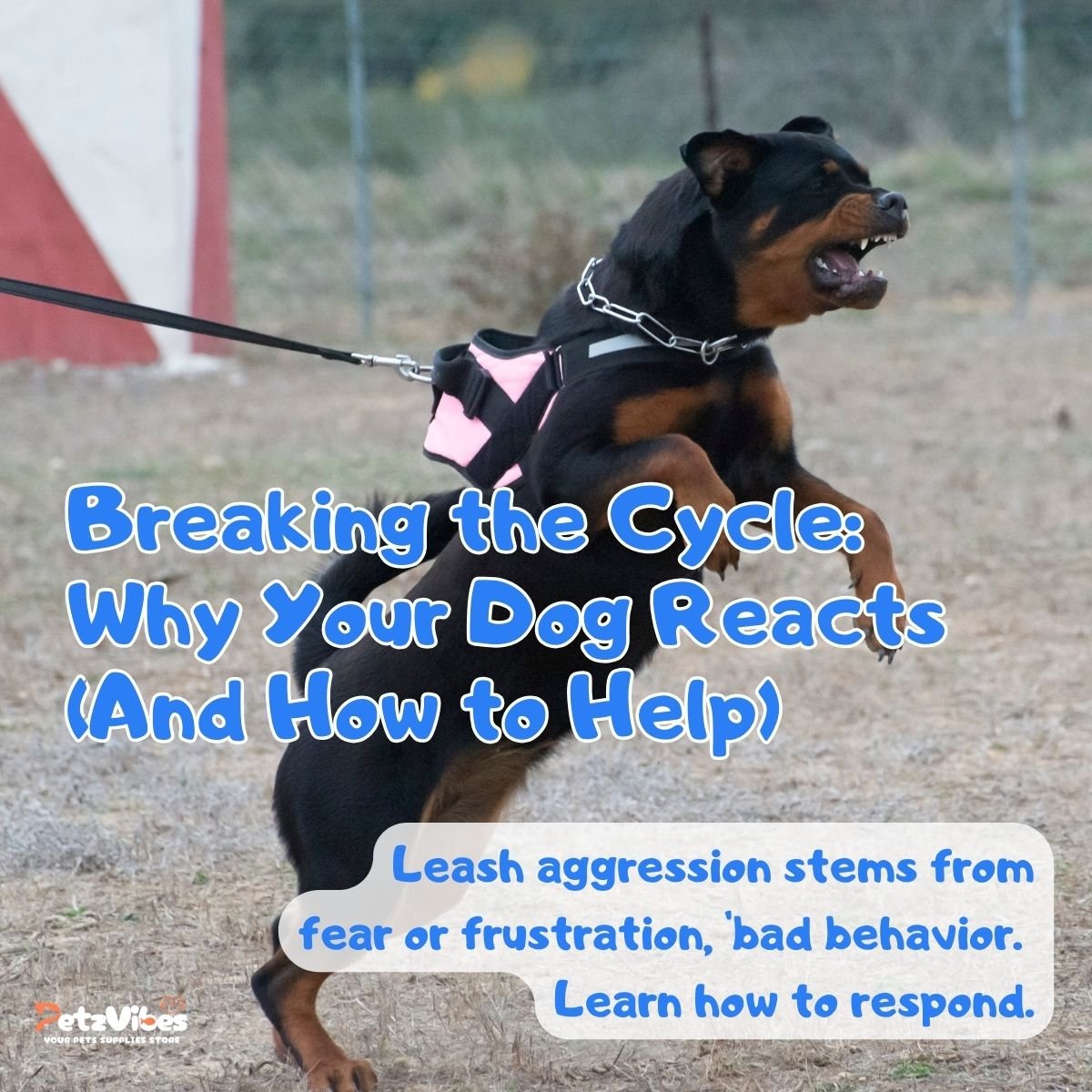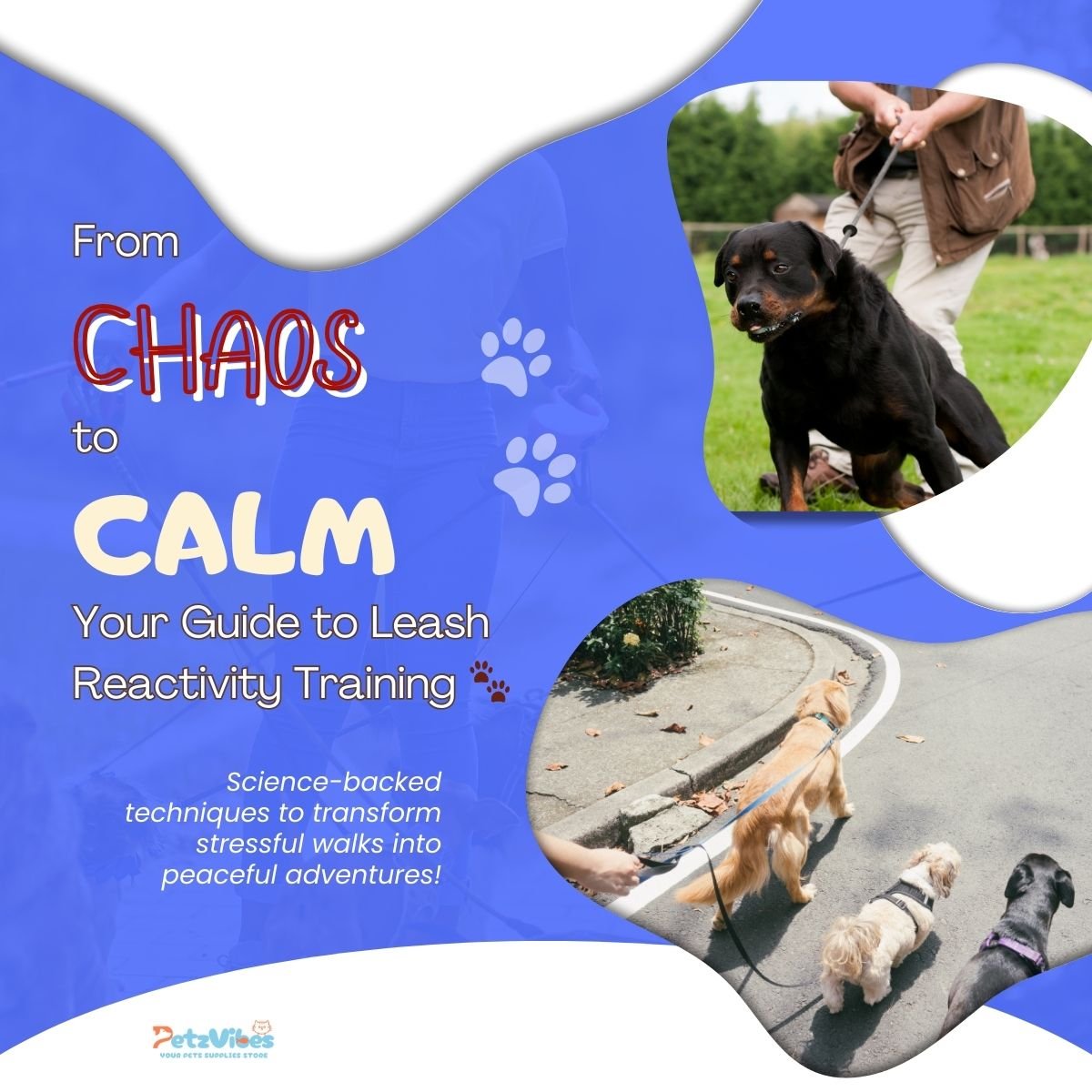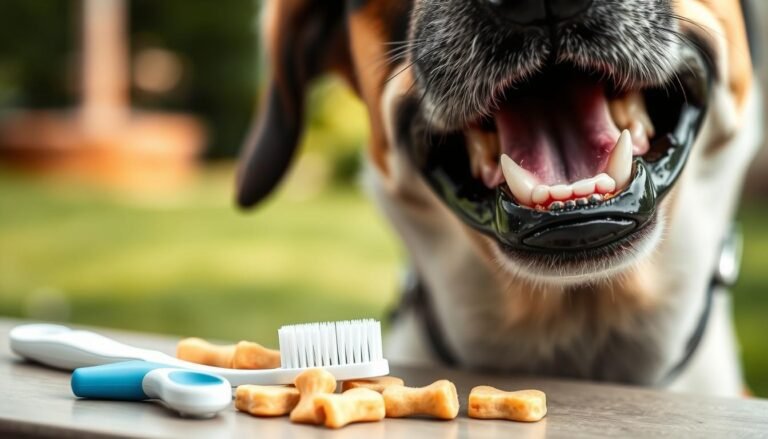Master Leash Reactivity Training: Turn Stressful Walks Into Peaceful Adventures 🐕🦺
You’re not alone if every walk with your reactive dog feels like navigating a minefield. Leash reactivity training can transform those tense outings into enjoyable bonding experiences—and it all starts with understanding why your dog reacts and how to help it feel safe.
When your dog lunges, barks, or spins at the end of its leash, it is not being disobedient or “bad.” It communicates only how it knows how: “I’m scared!” “I’m frustrated!” or “I don’t know what to do!” The leash can worsen things by removing the dog’s natural ability to avoid or approach situations comfortably.
Here’s what science tells us:
- Reactivity stems from your dog’s amygdala (the brain’s fear center) going into overdrive
- Stress hormones like cortisol flood the system during reactive episodes
- With the right leash reactivity training, we can actually rewire their stress responses
In this complete guide, you’ll discover:
✔️ Why your dog reacts (it’s not what you think)
✔️ How to train calm behavior using stress-free methods
✔️ When to know if you need professional help
✔️ What tools work (and which make things worse)
Leash reactivity doesn’t have to be a life sentence. Whether your dog is fearful, frustrated, or overexcited, the solutions start here—with compassion, science, and proven strategies that work for real dogs in the real world.
“The journey of a thousand miles begins with one calm walk.” Let’s get started.
🔑 Key Takeaways:
✔ Leash reactivity is fixable – Your dog isn’t “bad,” just overwhelmed
✔ Science-backed methods work by retraining your dog’s stress response
✔ Consistency beats intensity – Short, daily sessions > long, sporadic ones
✔ Your calm energy matters – Dogs mirror our emotions
✔ Progress isn’t linear – Celebrate small wins and expect setbacks
🧠 The Science Behind Leash Reactivity

Neurology of Reactivity
When your dog sees a trigger (another dog, a bike, etc.), their brain reacts in 3 explosive steps:
-
Amygdala activation: This almond-shaped fear center screams “Danger!”—even if the threat isn’t real.
-
Cortisol surge: A 2014 study (link to research) showed reactive dogs have 200% higher cortisol levels during leash episodes.
-
Body lockdown: The leash prevents escape, so they fight (barking/lunging) or freeze (shutting down).
Key Insight: Reactivity isn’t disobedience—it’s a panic response. Punishment worsens it!
🌋 Thresholds Explained
Imagine your dog’s stress as a volcano:
- Calm (Green Zone): Ears relaxed, loose leash. ✅ Training works here!
- Alert (Yellow Zone): Stiff body, staring. ⚠️ Distract now with treats!
- Over Threshold (Red Zone): Barking/lunging. 🚨 Stop training—just leave.
Pro Tip: Work in the Yellow Zone to build confidence. Pushing too fast floods their brain with stress hormones, making learning impossible.
Why Do Dogs Become Reactive?
Leash reactivity isn’t about “bad behavior” – it’s your dog’s way of coping with big emotions. Science helps explain why:
Fear (The Amygdala Hijack)
- When leashed, dogs can’t escape perceived threats, triggering their amygdala (the brain’s fear center)
- A 2020 study showed fearful dogs have 43% stronger amygdala reactions than confident dogs
- Common fear triggers:
- Strange dogs approaching
- Loud noises (cars, bikes)
- Fast-moving objects
Frustration (Barrier Rage)
- That’s lunging at other dogs? Often frustrated greeting behavior
- The leash creates “barrier frustration” – they want to meet but can’t
- Signs of frustration reactivity:
- Whining with a wagging tail
- Pulling toward triggers
- High-pitched barking
Lack of Socialization
- Puppies need positive experiences with 100+ new things before 16 weeks
- Under-socialized dogs often react because:
- They’ve never learned dog manners
- New things seem scary
- They don’t understand normal dog signals
💔 Owner Mindset & Emotional Impact
“It’s Not Your Fault”
Reactivity is more common than you think:
- 15-20% of dogs show leash reactivity (ASPCA data)
- Even professional trainers deal with reactive dogs
- Your dog isn’t giving you a hard time – they’re having a hard time
😰 Walking Anxiety Self-Test
Your stress directly affects your dog. Ask yourself:
✅ Do I hold my breath when I see another dog?
✅ Does my grip tighten on the leash?
✅ Do I avoid walks because I’m embarrassed?
If you answered yes, you accidentally told your dog, “There’s danger ahead!”
📓 Reactivity Journal Prompts
Track patterns with these questions:
- What triggered the reaction? (Dog, person, noise)
- How far away were we?
- What worked to calm them?
- How was I feeling at the time?
Training Foundation
Before tackling reactivity, build these essential skills:
Basic Obedience Must-Knows
- “Watch me” (eye contact) – #1 most useful command
- “Leave it” – for ignoring triggers
- “Let’s go” – emergency U-turn cue
Socialization Done Right
- Not about meeting every dog – about positive exposure
- Try the “Rule of 7”:
- 7 types of people (hats, uniforms, etc.)
- 7 surfaces (grass, metal, etc.)
- 7 sounds (traffic, kids playing)
Positive Reinforcement 101
- Use high-value treats (real meat > kibble)
- Timing matters: Reward within 2 seconds of good behavior
- The Golden Rule: Ignore what you don’t want, reward what you do
🎯 Advanced Training Techniques for Stubborn Reactivity
BAT (Behavior Adjustment Training) – The Empowerment Method
Developed by animal behaviorist Grisha Stewart, BAT 2.0 is revolutionary because it:
- Gives dogs agency: Unlike traditional methods, where owners control everything, BAT lets your dog make choices to build confidence
- Works with thresholds: Uses the “3 D’s” – Distance, Duration, Distraction
- Practical setup:
Equipment needed: 15-30 ft long line, high-value treats, harness
Environment: Start in quiet parks during off-hours
Session example: When your dog notices a trigger 50 ft away and chooses to sniff the ground instead of reacting, immediately reward with a treat tossed away from the trigger
Why this works: A 2018 study in the Journal of Veterinary Behavior found BAT reduced reactivity symptoms by 72% when practiced 3x weekly for 8 weeks.
🔄 The Engage-Disengage Game – Clicker Edition
This builds on classic counterconditioning with precision timing:
-
Setup: Arm yourself with a clicker and pea-sized treats (real meat works best)
-
Steps:
-
- Phase 1: Click the moment your dog notices a trigger (before they react)
- Phase 2: Toss treats behind you so they turn away
- Phase 3: Gradually delay the click until they glance at you voluntarily
-
Progression: Move from stationary (sitting at a park bench) to walking over 2-4 weeks
Common mistake: Clicking too late (after the reaction starts). Watch for the first ear perk or body freeze.
🔢 Pattern Games – The Predictability Solution
Created by Leslie McDevitt, these games reduce anxiety through repetition:
*”1-2-3 Walk” Deep Dive*:
- Why it works: Creates predictable patterns in unpredictable environments
- Advanced variation:
- Walk three steps, saying “1-2-3”
-
- On “3”, stop and scatter 5-10 treats in the grass
- Gradually introduce triggers during the counting phase
- Eventually replace food scatter with quick petting for dogs who love affection
Real-world application: Perfect for transitioning from quiet neighborhoods to busier areas.
🚧 Troubleshooting Setbacks – The Reality Check
❌ Why Most Owners Hit Plateaus (And How to Fix Them)
-
Moving too fast:
Signs: Your dog reacts at distances they previously handled calmly
Solution: Revert to last successful distance + add 20% more space
Example: If your dog reacted at 30 ft today, start next session at 36 ft -
Treat quality failures:
Test: Would your dog ignore a squirrel for these treats?
Treat hierarchy:
-
- Fresh meat (chicken, steak)
- Specialty dog treats (Freeze-dried liver)
- Kibble (only for low-distraction environments)
-
Inconsistency:
Minimum effective dose: Three 5-minute sessions weekly maintain progress
Calendar hack: Schedule training like medical appointments
🔄 Regression Survival Guide
Every dog has bad weeks. Here’s how to troubleshoot:
Diagnostic checklist:
- Has the environment changed? (Construction noises, new pets at home)
- Any health changes? (Ear infections increase reactivity)
- Has your routine shifted? (Less exercise = more reactivity)
Reset protocol:
- Take 3 days off from formal training
- Switch to decompression walks in nature
- Reintroduce training with easier versions of known games
🏙️ Real-Life Management – Beyond the Training Session
📱 Tech That Actually Helps (Not Distracts)
-
Dogo App Deep Dive:
Best features:- Reactive dog-specific programs
- Built-in progress tracker with graphs
- Community support groups
Limitations: Doesn’t replace professional help for severe cases
- GPS Collars – Smart Use:
When to use: -
- Practicing recall in safe, enclosed areas
- Monitoring stress levels via activity tracking
Safety rules:
-
-
- Never use as punishment
- Combine with positive reinforcement
- Remove when not training
-
Budget option: A simple 100 ft long line provides similar freedom at 1/10th the cost.
🧠 Myth-Busting: The Truth About Reactivity
❓ “Will Letting My Dog Greet Others Fix Reactivity?”
The Hard Truth: This common mistake often worsens reactivity. Here’s why:
- Reinforces that lunging = access to other dogs
- Overwhelms your dog’s stress capacity
- Creates “frustration cycles” (barrier aggression)
Better Approach:
- Teach calm behavior first
- Use parallel walking (dogs moving together at safe distances)
- Only allow greetings after mastering focus commands
Study Note: 2016 research in Applied Animal Behavior Science showed that on-leash greetings increased reactivity in 68% of cases.
⚖️ “Is Reactivity the Same as Aggression?”
Key Differences:
| Reactivity | Aggression |
|---|---|
| Emotional overreaction | Intent to harm |
| Often fear-based | Typically threat-based |
| Improves with distance | May escalate with distance |
| Responsive to counterconditioning | Requires behavior modification |
When to Worry: If your dog shows:
- Prolonged staring with a stiff body
- Intentional biting (not nip-and-run)
- Resource guarding combined with reactivity
🐕 Breed-Specific Tips That Actually Work
High-Energy Breeds (Huskies, Border Collies)
- Pre-walk routine: 15-minute flirt pole session
- Special challenge: Movement triggers (bikes, runners)
- Best technique: “Find it” games with scattered treats
Guardian Breeds (GSDs, Rottweilers)
- Key trigger: Perceived territorial threats
- Essential skill: “Watch me” with duration building
- Equipment: Front-clip harness + traffic handle
Sighthounds (Greyhounds, Whippets)
- Unique issue: Prey drive reactivity
- Solution: Pattern games before walks
- Caution: Never use retractable leashes
Surprising Fact: A 2022 study found herding breeds showed 40% faster progress with movement-based training vs stationary exercises.
❓ FAQ: Science-Based Answers to Your Top Concerns
-
Can medication help?
Answer: For severe cases, vets may prescribe SSRIs like fluoxetine (Prozac) to lower anxiety thresholds. Always consult a vet behaviorist. [Link to AVMA guidelines] -
How long until we see progress?
Answer: Most dogs show improvement in 4-6 weeks with consistent training. Complete management takes 3-6 months. -
Is my dog too old for this training?
Answer: Dogs of any age can learn! Senior dogs may need adjusted sessions (shorter duration, softer treats). -
Why does my dog react at home, too?
Answer: “Barrier frustration” applies to windows and doors. Use window film and play white noise during trigger times. -
Should I use a prong collar?
Answer: Studies show aversive tools increase stress hormones by 300%. Force-free methods are safer and more effective in the long term. -
How do I stay patient?
Answer: Track micro-wins (e.g., “Today he noticed a dog but didn’t bark for 3 seconds”). Celebrate every step! -
Can reactivity be cured completely?
Answer: While some dogs fully overcome it, most learn management skills. Think of it like human anxiety—tools to cope vs. “fixing.”
🏁 Conclusion: Your Roadmap to Peaceful Walks Starts Here
You’ve just armed yourself with the most powerful tools to transform stressful walks into enjoyable adventures with your dog. Remember:
🌱 Progress Over Perfection
- Leash reactivity training isn’t about achieving a “perfect” dog, but consistent, compassionate progress.
- Celebrate micro-wins: A glance instead of a lunge. Three seconds of calm where there used to be chaos. These are the building blocks of real change.
🧠 The Science of Patience
- Your dog’s brain is rewiring itself. Studies show that forming new neural pathways takes 6-8 weeks of consistent practice.
- Think of training like physical therapy: You wouldn’t expect a sprained ankle to heal overnight. Emotional wounds take time, too.
🚦 When Setbacks Happen (Because They Will)
-
The 3 R’s of Regression:
-
- Reset: Go back to the last successful distance/trigger level.
- Reassess: Was there a new stressor? Less sleep? A change in routine?
- Reinforce: Double down on foundational skills for 3-5 days before progressing again.
💡 Your Toolkit for Long-Term Success
-
- The Reactivity Journal (Download here) – Track triggers, progress, and “lightbulb moments.”
- The 5-Minute Rule: A tiny training session maintains momentum even on busy days.
- Community Support: Join our Reactive Dog Warriors Facebook group for real-time advice.
🌟 Final Thought
Every expert dog trainer was once where you are now. The difference between frustration and freedom is simply sticking with it.
Resources
-
How Can I Safely Walk My Reactive Dog?” – American Animal Hospital Association (AAHA)
https://www.aaha.org/resources/how-can-i-safely-walk-my-reactive-dog/
Covers veterinary behaviorist insights, safety gear, and stress reduction techniques 112. -
“Let’s Talk: Enjoyable Walks with a Reactive Dog” – Patricia McConnell, PhD (Certified Applied Animal Behaviorist)
https://patriciamcconnell.com/lets-talk-enjoyable-walks-with-a-reactive-dog
Science-based methods like desensitization and emergency cues from a renowned expert 3. -
“Reactive Dog Training: Tips To Help Your Dog Get Better” – Spirit Dog Training
https://spiritdogtraining.com/reactive-dog-training






